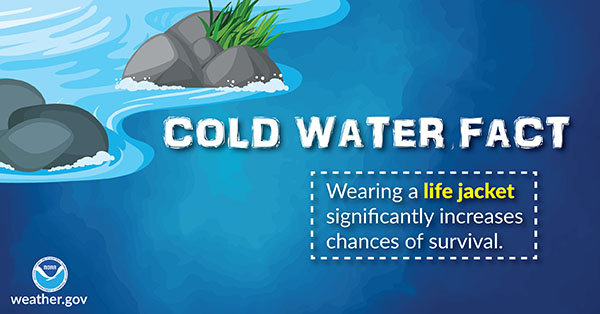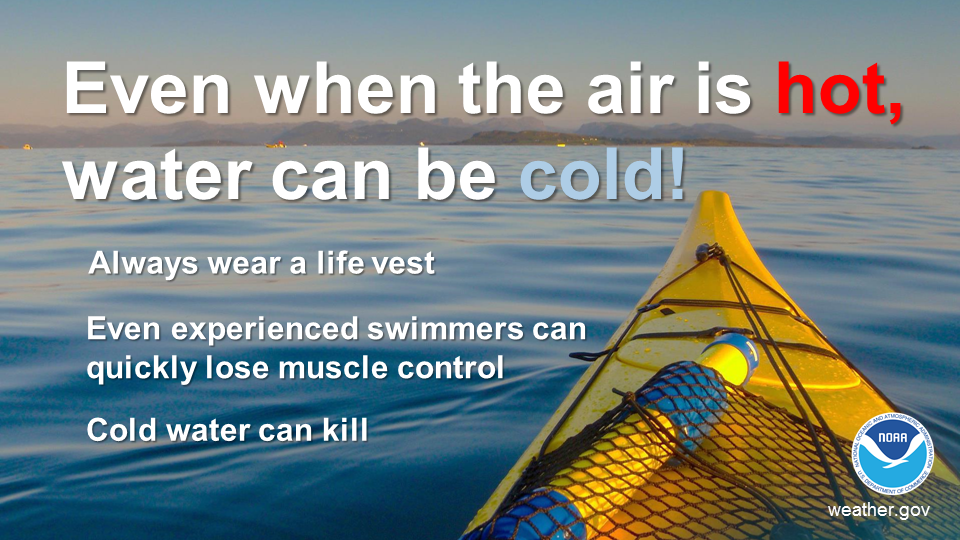
Warm air doesn’t always mean warm water in lakes, streams or oceans, and even water temperature that may not sound very cold can be deadly. Plunging into cold water of any temperature becomes dangerous if you aren’t prepared for what the sudden exposure can do to your body and brain. Warm air temperatures can create a false sense of security for boaters and beach goers, so if you are planning to be on or near the water, arrive knowing the conditions and how to protect yourself.
When your body hits cold water, “Cold Shock” can cause dramatic changes in breathing, heart rate and blood pressure. The sudden gasp and rapid breathing alone creates a greater risk of drowning, even for confident swimmers in calm waters. In rougher open water, this danger increases. Unplanned immersion in cold water can be life-threatening for anyone without protection from the temperatures or a lifejacket to help you stay afloat. When Cold Shock and Hypothermia begin to impact your ability to think and act, lifejackets and floatation can create extra time for help to arrive or for you to get out of danger. Even the most experienced cold water surfers, swimmers or boaters know to prepare for the conditions.
Knowing what happens when you enter cold water and what you can do in those first seconds could save your life and give time for help to arrive.
COLD SHOCK
Gasping for Breath & Rapid Breathing (occurs during the first 2-3 minutes or more)
Cold Water Immersion can trigger involuntary gasping, rapid breathing or hyperventilating due to the “shock” of sudden immersion. This uncontrolled rapid breathing can quickly create a drowning emergency if you inhale water and cannot stay afloat.
Heart and Blood Pressure Problems
Cold water can cause a sudden spike in heart rate and blood pressure. This increase can cause heart failure and stroke for vulnerable people.
Cognitive Impairment
Cold Shock can cause an immediate panic, fear or stress reaction that then impairs clear thinking and decision making. Extended exposure and the onset of hypothermia can further hamper cognitive ability and the ability to choose the right actions to avoid severe injury or death.
PHYSICAL INCAPACITATION
Physical incapacitation is a loss of muscular control in the arms, legs, hands and feet. The impact can be felt within seconds of entering cold water, and the longer the exposure or the colder the water, the more severe the impact can become. Symptoms of physical incapacitation may include weakness, exhaustion, and an inability to control fingers, hands, arms or legs. The progressive loss of muscular control makes self-rescue or staying afloat without assistance virtually impossible. A loss of muscular control to keep your head above the water plus a lack of a lifejacket or floatation device means drowning will become inevitable
HYPOTHERMIA
The onset of hypothermia begins when core body temperature drops to 95°F (35°C). After the initial dangers of Cold Shock in the first few minutes of immersion, a person’s body temperature will continue to drop, increasing the risk of drowning or death. As core body temperature continues to drop, impairments to physical and cognitive ability increase until drowning or death without rescue become inevitable.
After escaping from cold water, get into a warm, dry, protected environment as quickly as possible. Even removed from cold water, a victim’s core temperature can continue to drop to dangerous levels.
Cold water risks come from immersion into any body of cold water, including oceans, lakes, rivers, streams or pools. In many places, parts of the year, or bodies of water, warm air temperatures may not coincide with safer, warm waters. Many areas of the country have warm days, yet the water stays cold, such as in the Pacific Northwest, where ocean temperatures may stay in the 60’s year round. In the waters around Annapolis, MD, temperatures may only be above 60°F for 5.5 months of the year. Weather conditions along any large body of water can also cause dramatic drops in water temperatures, even in the middle of summer. Cold Shock and the dangers of sudden cold water immersion can happen along almost any shore at any time of the year
Risks that may cause immersion in cold water include:

Being prepared for an outing on cold water means being prepared for the possibility of suddenly being immersed into cold water. Your ability to survive cold water immersion depends on your ability to stay afloat and to stay warm until help arrives. Below are several things to consider prior to venturing out on cold water.

Cold water can kill. The following guidelines and images from the U.S. Coast Guard will increase your chance for survival:
 H.E.L.P. |
 Huddle position |
If you need to treat yourself or someone else that has been submerged in cold water, follow the steps below (developed by the Red Cross):